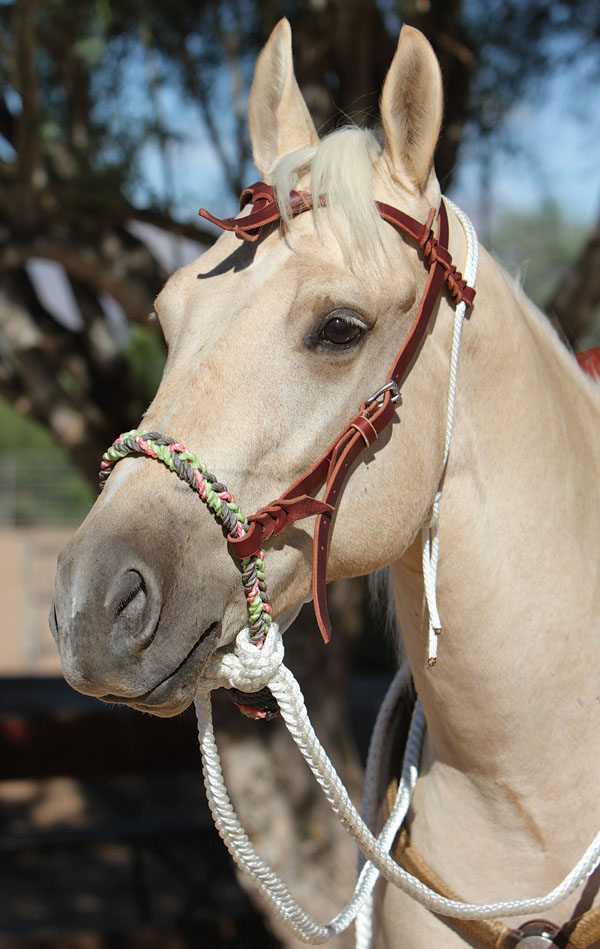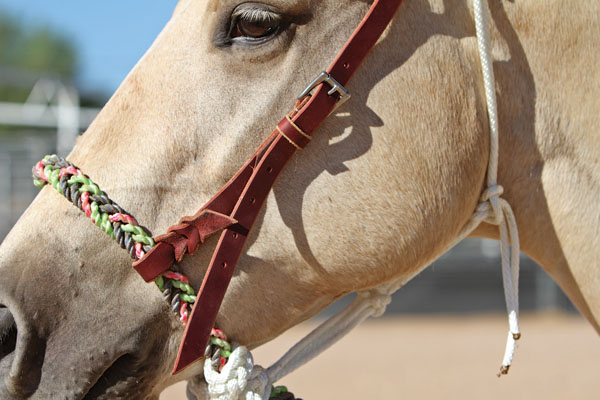Whether you’re a seasoned showman or casual rider, training and sidepull hackamores are effective tools to develop your horse’s feel and responsiveness while giving him a break from his everyday-riding bridle. Also referred to as a lope rope or a breaking hackamore, this light piece of equipment is set up similarly to a traditional hackamore, but uses soft materials that feel to your horse more like a nylon halter. It consists of a hanger that’s placed at your horse’s poll and attaches to and holds the noseband in place, an adjustable throatlatch strap, and a brow band. The reins attach via a fiador knot (sometimes called a hackamore knot) below your horse’s chin, or to either side of your horse’s nose for a sidepull setup.

Here you’ll learn how to best incorporate this riding aid into your routine, as well as how to fit and care for it.
Materials
A training hackamore setup incorporates a light headstall with thick, braided nylon reins. The noseband is typically made of single-strand or braided rope or rawhide. Soft leather is used for the hanger and brow band.
Rope nosebands can be made of nylon, poly or poly blend, hemp, or other materials. Typically the most cost-effective options, these also are the easiest to maintain. Rope nosebands are available in single-strand or multi-strand braided variations, in varied thicknesses and styles to accommodate the amount of pressure desired.
Rawhide nosebands are attractive and functional options that may provide additional feel on your horse’s nose, depending on the stiffness of the material used.
Sizing
The noseband should be adjusted loosely enough that there’s space between the noseband and your horse’s muzzle. This’ll allow room for some play, though there shouldn’t be so much room that it’ll slide up your horse’s nose. Adjust the hanger so the noseband sits on the bridge of his nose, or a little lower. Note: Be aware though, that if adjusted lower on your horse’s nose, too much pressure on the nasal passage could inhibit his airway, upsetting him. So keep your hands light.
Size used varies based on the breed and size of your horse and his head size. The hanger ranges in length from 38 to 46 inches, the brow band from 15½ to 18 inches, and the noseband from a 20- to 28-inch circumference.
Styles
There’s little variety in style, as a training hackamore is of relatively simple construction, consisting of a light, bitless headstall and set of heavy reins. Thick reins allow a rider to reach farther down the rein for more direct control. The piece varies most in the thickness of the noseband and the rein attachment location.

Noseband: Rope nosebands are available in single or double braids, depending on the amount of pressure desired. Double-braided nosebands are wider to distribute the signal across the horse’s nose, whereas a single-braid noseband concentrates the cue to garner a sharper response.
Rein attachment: A sidepull is similar in overall setup, but has rings on either side of the noseband where the reins attach, rather than the fiador-knot attachment seen with a training hackamore (see photo, page 40). This rein position enables direct, lateral-pressure cueing with minimal neck reining. Sidepulls are used primarily to start green horses.
The fiador attachment, or training hackamore, is best used to give your horse’s mouth a reprieve on an easy trail ride, for a lope warm-up, or to start a colt.
Care
The materials used require little maintenance. Most nylon pieces simply can be wiped or rinsed off and then stored. Leather and rawhide nosebands will need additional care, such as oiling. Because this training tool isn’t an everyday riding piece, it’ll last years without replacement. The reins and headstall usually will need to be replaced before the noseband.
Al Dunning, Scottsdale, Arizona, has produced world champion horses and riders in multiple disciplines. He’s been a professional trainer for more than 40 years, and his expertise has led him to produce books, DVDs, and his own online mentoring program, Team AD International (teamadinternational.com).






